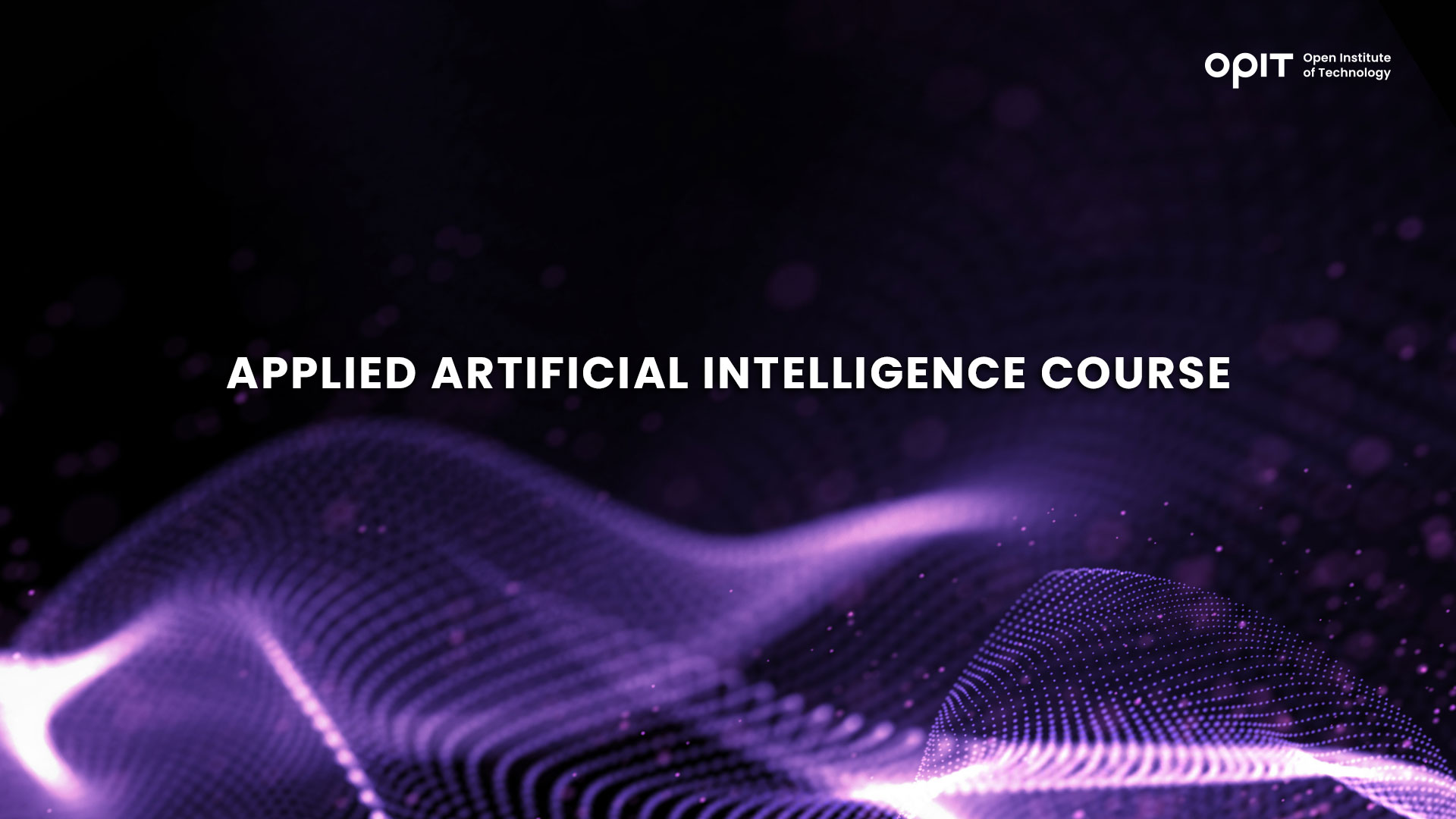Read the full article below (in Italian):


Growth is inevitable in the AI sector. According to Statista, the already-booming industry looks set to go from a value of $100 billion in 2021 to $2 trillion by 2030, increasing by a multiple of 20 to become one of the world’s biggest industries. Naturally, the need for skilled AI professionals will grow alongside that enormous scaling.
That’s where you come in.
With the right applied AI course, you can develop both the knowledge of the foundational theory that sits behind AI and learn how to apply that theory in a real-world setting. Here are four of the best applied AI courses to get you started.
Factors to Consider When Choosing an Applied AI Course
Every search for a new course starts with figuring out the strengths and weaknesses of each one you consider. These factors help you do that, ensuring you don’t spend your hard-earned money on a course that fails to equip you with skills that make you desirable to employers.
Course Content and Curriculum
AI is such an expansive field that every applied AI course has the potential to cover different topics and subjects. Think about what you want to learn (and your prospective career path), then align your course selection with that intended path.
Course Duration
Applied AI courses can vary tremendously in length, from several years for degree-level courses to a few months for online courses. Ask yourself how long you wish to spend studying. Also, consider the flexibility of the course, such as whether you’ll be able to fit your studies around your existing work and family commitments.
Instructor Expertise
AI is a burgeoning industry, meaning expertise levels vary from course to course. For applied AI courses, in particular, you want professors who combine in-depth knowledge of the theory with real-world experience. What have they done in the industry? If the answer is “nothing,” they may not be able to guide you down the path to an AI-centric career.
Course Fees and Financial Aid
Course fees vary massively depending on the type of course you take. For example, those in the U.K. can easily spend between £15,000 and £25,000 on university-level courses, with Aston University’s tuition fees of £23,200 being somewhat typical. Online and self-learning courses cost considerably less, so you need to figure out how much you’re willing to spend (and if you can get any help with your fees) before moving forward.
Job Placement and Career Support
Though you need one eye pointed toward the present when choosing between applied AI courses, the other needs to be firmly pointed toward the future. What prospects will you have when you complete the course? In other words, does the course provide you with a direct path into the industry, along with support, or are you left to fend for yourself once you have your qualification?
Top Choices for Mastering Artificial Intelligence
Choices abound when you jump online to find applied AI courses. The following selection offers a nice mix, from online certifications offered by industry professionals to a couple of courses from some of the world’s most prestigious universities.
Course 1 – IBM Applied AI Professional Certification
If you’re fresh to the world of AI (though ideally not new to computer science), IBM’s industry-specific applied AI courses offer both foundational knowledge and a respected qualification. They’re flexible, too, with this course lasting for six months but only requiring three hours of work per work. Those in full-time work (or education) can fit the course around their lifestyle, while those who have time to burn can complete the entire course much quicker, earning degree credits along the way.
Key Features and Benefits
- Certification from one of the most respected companies in the AI space
- Direct exposure to use cases in the deep learning, machine learning, and neural network spheres
- Learn how to build AI-powered solutions (like chatbots) using Python and IBM’s Watson AI
- Over three-quarters (77%) of students report career improvement
Pricing and Enrollment
IBM’s course is available via Coursera and offers a seven-day trial you can use to get to grips with its structure and examine its modules. It’s fully online, which improves flexibility at the cost of not having direct access to a professor, and you’ll receive an IBM badge upon completion. You’ll pay a monthly fee of $35 (approx. €31) and can enroll at almost any time.
Course 2 – Computer Science for Artificial Intelligence (Harvard University)
Harvard University may be seen as the gold standard in the United States, but what many don’t know is that it offers a comprehensive suite of online courses that almost anybody can take. Its Computer Science for Artificial Intelligence course is a perfect example. Comprising of two courses – an introduction to computer science followed by an introduction to applying computer science principles to AI using Python – it lasts for five months. You get access to professors and can learn at your own pace, with the course recommending between seven and 22 hours of study per week.
Key Features and Benefits
- Two modules give you a crash course in applied AI and the computer science theory that underpins it
- Director access to Harvard professors Doug Lloyd, Brian Yu, and David J. Malan
- Complete flexibility in how and when you learn
- Get to grips with Python and build experience with machine learning libraries
Payment and Enrollment
As an online course, Computer Science for Artificial Intelligence is available for enrollment whenever you’re ready, with the five months starting once you’re enrolled. It costs £277 (approx. €312) and you’ll need to create an account with the EDX website (which hosts the course) to get started.
Course 3 – Artificial Intelligence Graduate Certificate (Stanford University)
Ranked as the third-best university in the United States for general computer science and AI teaching, Stanford University has opened up some of its best courses to online learners. Entirely online (and instructor-led for those who want more guidance) this is one of those applied AI courses that is equivalent to a full graduate degree. You’ll complete at least one required course – with a choice between machine learning and the principles of AI – and select up to three electives. It’s the electives that make this course stand out, as there are 18 to choose from, with the right combination giving you a chance to specialize for specific career paths.
Key Benefits and Features
- Direct tuition from prominent Stanford faculty members, including Andrew Ng and Chelsea Finn
- Some level of autonomy in how you study thanks to the online-centric nature of the course
- Specialize in specific areas of AI thanks to a wide range of electives
- You get a degree from one of the world’s foremost colleges in the AI field
Payment and Enrollment
Let’s get the bad news out of the way immediately – this isn’t a cheap course. As a full-on graduate degree, it costs between $18,200 and $22,400 to take (approx. €16,235 and €19,980), though financial aid may be available for some students. You can’t just hop onto the course, either, as a college-level understanding of calculus, linear algebra, Probability Theory, and several programming languages is required. Stanford itself calls this one of its most difficult courses and recommends that you take several foundation courses (ideally at degree level) before enrolling.
Course 4 – Master in Applied Data Science & AI (OPIT)
As a full postgraduate course that takes between 12 and 18 months to complete, OPIT’s Master in Applied Data Science & AI is an interesting case for one simple reason – there are no computer science prerequisites. The course is open to everybody and it teaches both advanced applied AI concepts and the foundational knowledge needed to understand them. You’ll complete a pair of terms containing courses, with your final term dedicated to a project or thesis that puts what you’ve learned into practice.
Key Benefits and Features
- The course is supplied by an institution with accreditation from the European Qualification Framework
- It’s a fully remote course that gives you control over how and when you learn
- Discounts and payment plans are available, as well as scholarship and funding options
- You come out of the course with a recognized postgraduate degree
Payment and Enrollment
Though the course usually costs €6,500, OPIT offers “early bird” discounts that allow you to enroll for €4,950, assuming you sign up early enough. Intakes are semi-regular, with the next one scheduled for October 2023 and international students get 90 credits under the European Credit Transfer and Accumulation System (ECTS) for successful completion.
Tips for Success in an Applied AI Course
As you can see, you have plenty of options for applied AI courses, from professional certifications designed to get you into a career quickly to full postgraduate degrees. Regardless of your choice, these tips will help you get your precious certification:
- Dedicate time for study – Time well managed is time well spent. Understand that you’ll need to dedicate self-learning time to get to grips with concepts you’re taught during classroom hours.
- Set clear goals – Going into an applied AI course with no sense of what you’re supposed to get out of that course leaves you directionless upon completion. Make sure you know exactly what you stand to gain before committing time (and money) to a course.
- Network often – Even online courses give you a chance to get involved in teamwork projects and speak to experienced industry professionals. Take those chances. The more connections you build during your studies, the more opportunities you’ll see coming out of the back end.
- Seek guidance – As attractive as the prospect of self-guided learning may be, we all need a helping hand from time to time. If a course provides direct access to tutors and professors, use it.
- Stay up to date – AI is a fast-moving field, with every change and advancement bringing new challenges and opportunities. Stay on top of what’s happening in the industry. You may just find that one course sets you up to be ready for those changes, while another may not.
Build Your Skills With an Applied AI Course
Whether you go down the full postgraduate degree route or you choose a professional qualification, an applied AI course is a route into one of the world’s fastest-growing industries. Simply put, we’re set for an AI explosion. Over the next decade, AI will permeate everything we do, from complex computing to simple office tasks, and you can use the right course to give yourself the skills you need to take advantage of that fact. Explore the options shared in this article, ask yourself what you want to achieve in your career, and make the educational choice that’s right for you.
Related posts

Source:
- Agenda Digitale, published on June 16th, 2025
By Lokesh Vij, Professor of Cloud Computing Infrastructure, Cloud Development, Cloud Computing Automation and Ops and Cloud Data Stacks at OPIT – Open Institute of Technology
NIST identifies five key characteristics of cloud computing: on-demand self-service, network access, resource pooling, elasticity, and metered service. These pillars explain the success of the global cloud market of 912 billion in 2025
Read the full article below (in Italian):

You’ve probably seen two of the most recent popular social media trends. The first is creating and posting your personalized action figure version of yourself, complete with personalized accessories, from a yoga mat to your favorite musical instrument. There is also the Studio Ghibli trend, which creates an image of you in the style of a character from one of the animation studio’s popular films.
Both of these are possible thanks to OpenAI’s GPT-4o-powered image generator. But what are you risking when you upload a picture to generate this kind of content? More than you might imagine, according to Tom Vazdar, chair of cybersecurity at the Open Institute of Technology (OPIT), in a recent interview with Wired. Let’s take a closer look at the risks and how this issue ties into the issue of responsible artificial intelligence.
Uploading Your Image
To get a personalized image of yourself back from ChatGPT, you need to upload an actual photo, or potentially multiple images, and tell ChatGPT what you want. But in addition to using your image to generate content for you, OpenAI could also be using your willingly submitted image to help train its AI model. Vazdar, who is also CEO and AI & Cybersecurity Strategist at Riskoria and a board member for the Croatian AI Association, says that this kind of content is “a gold mine for training generative models,” but you have limited power over how that image is integrated into their training strategy.
Plus, you are uploading much more than just an image of yourself. Vazdar reminds us that we are handing over “an entire bundle of metadata.” This includes the EXIF data attached to the image, such as exactly when and where the photo was taken. And your photo may have more content in it than you imagine, with the background – including people, landmarks, and objects – also able to be tied to that time and place.
In addition to this, OpenAI also collects data about the device that you are using to engage with the platform, and, according to Vazdar, “There’s also behavioral data, such as what you typed, what kind of image you asked for, how you interacted with the interface and the frequency of those actions.”
After all that, OpenAI knows a lot about you, and soon, so could their AI model, because it is studying you.
How OpenAI Uses Your Data
OpenAI claims that they did not orchestrate these social media trends simply to get training data for their AI, and that’s almost certainly true. But they also aren’t denying that access to that freely uploaded data is a bonus. As Vazdar points out, “This trend, whether by design or a convenient opportunity, is providing the company with massive volumes of fresh, high-quality facial data from diverse age groups, ethnicities, and geographies.”
OpenAI isn’t the only company using your data to train its AI. Meta recently updated its privacy policy to allow the company to use your personal information on Meta-related services, such as Facebook, Instagram, and WhatsApp, to train its AI. While it is possible to opt-out, Meta isn’t advertising that fact or making it easy, which means that most users are sharing their data by default.
You can also control what happens with your data when using ChatGPT. Again, while not well publicized, you can use ChatGPT’s self-service tools to access, export, and delete your personal information, and opt out of having your content used to improve OpenAI’s model. Nevertheless, even if you choose these options, it is still worth it to strip data like location and time from images before uploading them and to consider the privacy of any images, including people and objects in the background, before sharing.
Are Data Protection Laws Keeping Up?
OpenAI and Meta need to provide these kinds of opt-outs due to data protection laws, such as GDPR in the EU and the UK. GDPR gives you the right to access or delete your data, and the use of biometric data requires your explicit consent. However, your photo only becomes biometric data when it is processed using a specific technical measure that allows for the unique identification of an individual.
But just because ChatGPT is not using this technology, doesn’t mean that ChatGPT can’t learn a lot about you from your images.
AI and Ethics Concerns
But you might wonder, “Isn’t it a good thing that AI is being trained using a diverse range of photos?” After all, there have been widespread reports in the past of AI struggling to recognize black faces because they have been trained mostly on white faces. Similarly, there have been reports of bias within AI due to the information it receives. Doesn’t sharing from a wide range of users help combat that? Yes, but there is so much more that could be done with that data without your knowledge or consent.
One of the biggest risks is that the data can be manipulated for marketing purposes, not just to get you to buy products, but also potentially to manipulate behavior. Take, for instance, the Cambridge Analytica scandal, which saw AI used to manipulate voters and the proliferation of deepfakes sharing false news.
Vazdar believes that AI should be used to promote human freedom and autonomy, not threaten it. It should be something that benefits humanity in the broadest possible sense, and not just those with the power to develop and profit from AI.
Responsible Artificial Intelligence
OPIT’s Master’s in Responsible AI combines technical expertise with a focus on the ethical implications of AI, diving into questions such as this one. Focusing on real-world applications, the course considers sustainable AI, environmental impact, ethical considerations, and social responsibility.
Completed over three or four 13-week terms, it starts with a foundation in technical artificial intelligence and then moves on to advanced AI applications. Students finish with a Capstone project, which sees them apply what they have learned to real-world problems.
Have questions?
Visit our FAQ page or get in touch with us!
Write us at +39 335 576 0263
Get in touch at hello@opit.com
Talk to one of our Study Advisors
We are international
We can speak in:


